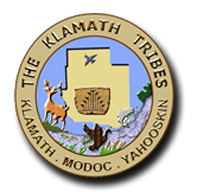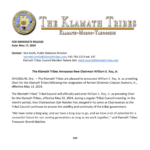FOR IMMEDIATE RELEASE
Date: July 7, 2023
Contact: Ken Smith, Public Relations Director
kenneth.smith@klamathtribes.com; 541-783-2219 ext. 147
Alex Gonyaw, Senior Fisheries Biologist Ambodat, 541-783-2148, ext. 224 alex.gonyaw@klamathtribes.com
Download full .pdf press release
Cyanobacteria Found in Upper Klamath Lake Exceeds Limit – An Ongoing Summer Problem
CHILOQUIN, Ore. – As has become a summer regularity, rising temperatures and land use-derived inputs of nutrients in Upper Klamath Lake has resulted in increased toxicity. And on June 25, the Oregon Health Authority (OHA) re-issued a recreational use health advisory for the southern portion of the Upper Klamath Lake due to the presence of cyanobacteria, a harmful algae bloom. Cyanobacteria was found between Howards Bay south and the Link River Dam, and the advisory still in effect.
The OHA stated that water monitoring has confirmed the presence of cyanobacteria and the toxins they produce in Upper Klamath Lake and that the cyanotoxin concentrations found can be harmful to humans and animals. Consuming fish caught where the blooms are found is also a possible health risk.
Alex Gonyaw, Senior Fisheries Biologist with The Klamath Tribes’ Ambodat facility stated that the impact on fish and wildlife is unknown, although there is no reason why it would not affect them in some way, he said. Ambodat is focused on the survival of the endangered suckers – koptu and c’waam – which are directly impacted by toxins in Upper Klamath Lake, inhibiting their ability to survive in the only lake they are found in Oregon in significant abundance. Gonyaw further cautions against human food chain contamination from the toxins in the lake.
“Microcystin, a powerful toxin that affects a variety of human organs, is present in Upper Klamath Lake as a result of modern land and water use practices,” Gonyaw said. “Peer-reviewed literature indicates that microcystin accumulates in a variety of above and below-ground food crops irrigated with microcystin-contaminated water,” he said, utilizing scientific research by Melaram, Newton, and Chafin (2022), and Crush, Briggs, Sprosen, & Nichols (2008).
“Prudent protective measures of public health, such as crop testing, comprehensive studies, and other due diligence items do not appear to have been taken by agriculturalists using water from Upper Klamath Lake,” Gonyaw further stated, “leaving uncertainty with respect to hazards to the public, workers, and the human food supply chain. The Klamath Tribes question the wisdom of, at a bare minimum, not regularly testing a representative sample of all crops watered with Upper Klamath Lake water during and after the recreational advisory period.”
Gonyaw emphasized that it is abundantly clear that the presence of toxins in crops is a potential issue that other countries have sought to address to be protective of human health, citing research by Miller, Russell, & Wiens (2017). “It’s something Upper Klamath Lake water users should address in an unbiased and scientifically valid manner,” Gonyaw said. If valid research and monitoring are performed, the Tribes urge agriculturalists to provide data to the public and relevant agencies demonstrating the confirmed safety of project crops with respect to microcystin.
The OHA advises the public to avoid swimming and high-speed water activities, such as water skiing or power boating, in areas where blooms are identified. “Although toxins are not absorbed through the skin, people who have skin sensitivities may experience a puffy red rash in the affected area,” the OHA stated.
It’s also dangerous to drink directly from the lake at this time, and OHA public health officials caution campers, in particular, to not rely on camping-style filters, which are ineffective in removing toxins by boiling, filtering, or treating water.
References:
Crush, JR, Briggs, JM, Nichols, SN. 2008. Effect of irrigation with lake water containing microcystins on microcystin content and growth of ryegrass, clover, rape, and lettuce. Environmental Toxicology 23: 246-252.
Miller, A, Russell, C, Wiens, M. 2017. Irrigating food crops with water containing cyanobacterial blooms. National Collaborating Centre for Environmental Health.
Melaram R, Newton AR, Chafin J. 2022. Microcystin contamination and toxicity: implications for agriculture and public health. Toxins 14: 350.

Upper Klamath Lake bordering Route 97. (Photo by Ken Smith/Klamath Tribes. Image available for media use.)
About The Klamath Tribes
The Klamath Tribes primary mission is to “protect, preserve and enhance the spiritual, cultural and physical values and resources of the Klamath, Modoc and Yahooskin Peoples by maintaining the customs of our ancestors.” The heart of Tribal life is centered in the area of Chiloquin, Oregon and includes 12 Departments, Health Clinic, Childcare Center, Tribal Court, goos oLgi gowa Center, Research Station, and three tribal enterprises. The Klamath Tribes’ 12 departments facilitate service delivery to multiple aspects of tribal life, including health and fitness, education, economic development, social services, cultural preservation, natural resource protection and more. For more information visit https://klamathtribes.org/.
###





